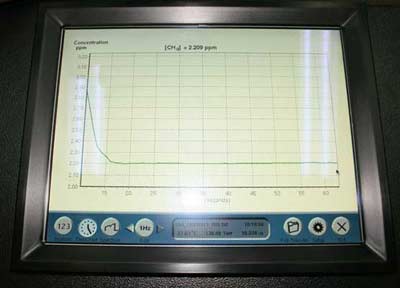| Fast Greenhouse Gas Analyzer (CH4, CO2, H2O)
 Typical Operating Parameters Repeatability/Precision (1-σ, 1 Hz, typical ambient levels)
CH4: 1 ppbv, CO2: 0.2 ppmv, H2O: 100 ppmv
Response Time (flow time through measurement cell)
0.1 seconds (with optional external pump)
25 seconds (with internal pump)
Accuracy
Total uncertainty <1% of reading
(without calibration)
Measurement Range (total uncertainty <1%, without calibration)
CH4: 0.005-10 ppmv, CO2: 200-4000 ppmv, H2O: 7000-70000 ppmv
Operational Range
CH4: 0.005-50 ppmv, CO2: 20-10000 ppmv, H2O: 150-70000 ppmv
Outputs
Digital (RS232), Analog, Ethernet
Data Storage
Internal Hard Drive (40 gigabytes)
Display
12.1" Color TFT (benchtop package)
Sample Temperature
0-50 °C
Operating Temperature
5-45 °C
Ambient Humidity
<98% RH Non-Condensing
Inlet/Outlet Fittings
1/4", 3/8", 1/2" Swagelok®
Power Requirements
115/230 VAC; 50/60 Hz; 90 W
(excluding optional external pump)
Dimensions (Benchtop Package)
10" H × 38" W × 14" D
Dimensions (Rackmount Package)
8.75" H × 19" W × 24" D
Weight
65 pounds (30 kg) - High Precision
- Wide Concentration Ranges
- Fast
- CH4 + CO2 + H2O (Vapor)
The Fast Greenhouse Gas Analyzer (FGGA) is the first instrument capable of both high accuracy and fast measurements of methane, carbon dioxide and water vapor.
The FGGA is designed to work in ambient air and to deliver accurate measurements over a wide range of concentrations at rapid response rates (sufficient for eddy correlation flux applications). In particular, the FGGA reports methane and carbon dioxide concentrations ranging from typical ambient levels to ten times ambient levels with the high accuracy that you expect from LGR instruments. Also, the FGGA is not adversely affected by other atmospheric gases (no cross interferences) or changes in ambient atmospheric pressure (no pressure broadening effects). If desired, the Analyzer may be operated on DC battery power with an appropriate
AC/DC inverter.
The FGGA suits many applications including eddy correlation flux measurements using established micrometeorological techniques, chamber flux measurements,
and leak detection from natural gas pipelines.
As described in the Theory Section, the measurement strategy is based on high-resolution direct-absorption spectroscopy. The instrument includes an internal computer that can store data practically indefinitely on its internal hard drive (for applications requiring unattended long-term operation), and send real-time data
to a data logger through its analog and digital (RS232) outputs. In addition, an Ethernet connection allows remote access to data files stored on the instrument’s
hard drive.
|

